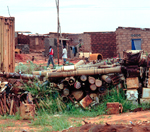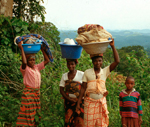War and landmines in Angola

25 years of Civil War in Angola leave behind a shattered nation

Angola - Country of contrast and a moving history with great potential for the future.
Report June 2011
25 years of civil war leave behind a shattered nation
When Portugal released its colony Angola as one of the last African nations into independence in 1975, it already became apparent that the three large, conflicting movements MPLA, UNITA and FNLA would not be able to come to a democratic agreement on the power sharing.
Fuelled mainly by the military intervention of Cuba with support from the Soviet Union on the side of the social-communistic MPLA as well as the westerly supported South Africa, the first and heaviest proxy war of the „Cold War“ on the African continent started directly after the end of the Vietnam War. After a first victory of Cuba against the FNLA, supported logistically and financially by the USA, The MPLA gained power in the Angolan capital Luanda; Angola became a pro Soviet country and a few years later José Eduardo dos Santos became president of Angola.
The fascist apartheid-regime of South Africa saw their political and economic interests in Angola jeopardised by the influence of the Eastern Block and send troops to Angola to support the rebel movement UNITA and thus fighting the MPLA supported, Namibian SWAPO form Angola. Although the USA avoided a direct military intervention after the Vietnam disaster, they still supported the UNITA financially and logistically and turned it into a highly embattled rebel movement under the leadership of Jonas Savimbi.
China also supported UNITA periodically. UNITA mainly financed its weapons through ivory and diamond sales, whilst MPLA funded its war machinery through oil. One example for “confusion”: Cuban and Angolan government soldiers are protecting an US-American oilfield from American supported UNITA troops. The suffering of the population was immeasurable, previously inhabited areas were depopulated. Constantly new weapons arrived in the country, especially from the Eastern Block and from South Africa, but also from the junk rooms of the Western world. West Germany brought in Mercedes (Unimogs), Magirus Deutz and MAN Lorries, whilst East Germany shone with IFA W50s and personnel mines PPM2.
After the events in the first years the international interest in the Angolan war disappeared only returning with the Battle of Cuito Canavale in 1988, one of the biggest fights on the African continent, during which approximately 20,000 soldiers and civilians lost their lives. Whilst the battle was still raging a peace treaty between the involved parties was negotiated and in December 1988 a ceasefire was decided, which was sealed with the arrival of UN peace troops in 1989. Nonethtless fights between Dos Santos and Savimbi errupted again in the same year.
After the end of the Cold War the Cubans and Angolans pulled out of Angola. Namibia became independent from South Africa and received an elected SWAPO government. In 1992 elections were organised in Angola. After Savimbi impeached the victory of the MPLA the civil war continued with great force. Both sides committed many crimes of war and neither side would budge.
When in 2002 Savimbi was killed during a military operation of the MPLA, the by then weakened UNITA saw itself forced to participate in peace talks. The new UNITA leadership formed into a political party and allowed itself to be disarmed – 27 years of civil war were enough.
Until today, nearly 10 years after the end of the war, Angola is still suffering the consequences of the dreadful civil war. Many traumatised people, including former child warriors and rape victims have to find a way into modern life. It is estimated that some hundred thousand people have to life with mutilations from landmines – nobody knows the exact number.

